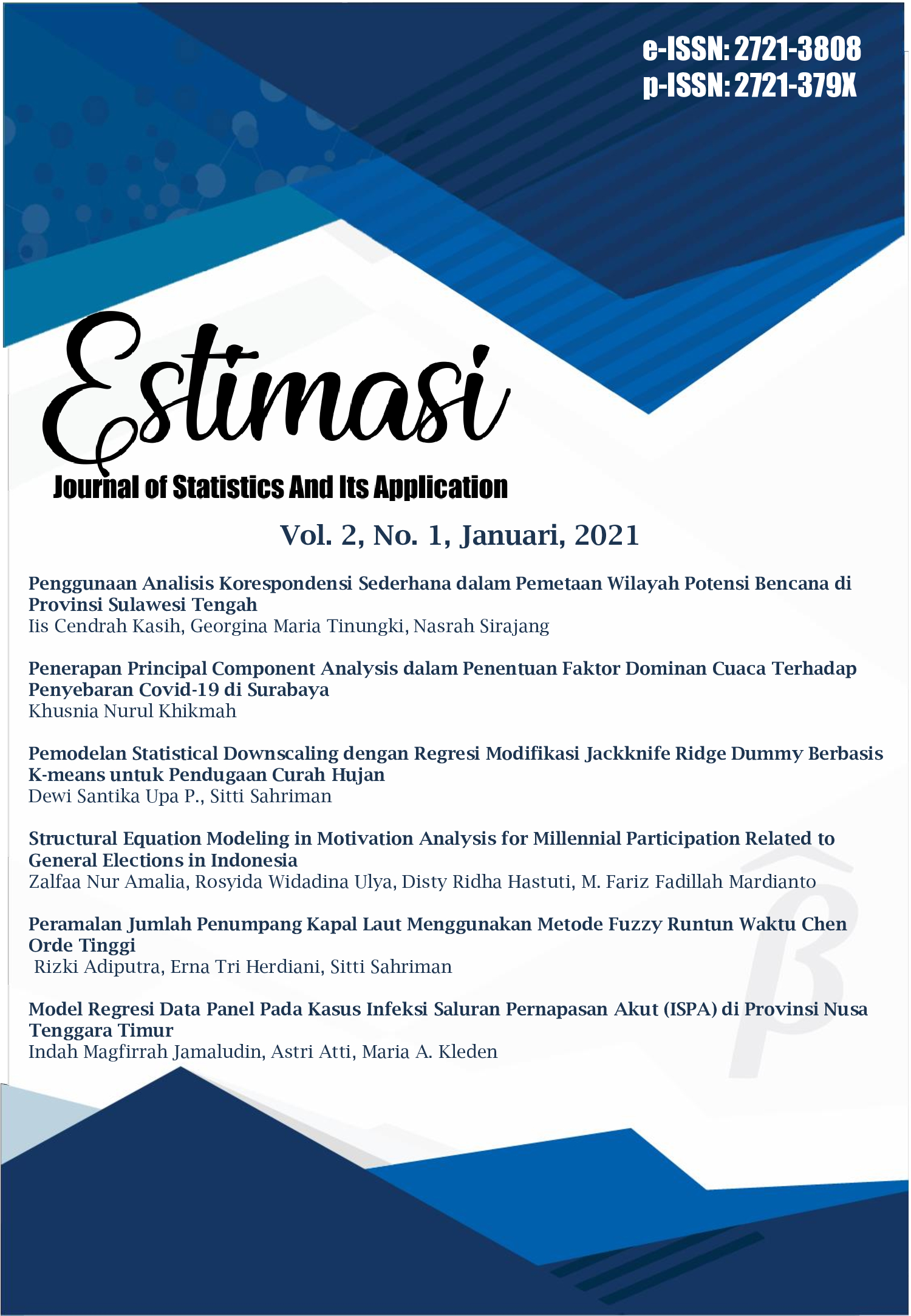Structural Equation Modeling in Motivation Analysis for Millennial Participation Related to General Elections in Indonesia
Structural Equation Modeling dalam Analisis Motivasi Partisipasi Milenial Terkait Pemilu di Indonesia
DOI:
https://doi.org/10.20956/ejsa.v2i1.12479Abstract
Structural Equation Modeling (SEM) is a statistical technique used to build and test the statistical models are usually in the form of causal models. SEM is a combination from factor analysis, path analysis, and regression. This method is a statistical approach that serves to test hypotheses about the relationship between observed variables and latent variables. In this paper, SEM is applied to determine the motivation of the millennial generation for the general election 2019 in Indonesia. Data was obtained by distributing questionnaires online according to procedures which were then analyzed using SEM. Millennial’s motivation is seen from the knowledge of the millennial generation on voting rights commitments in the 2019 general election in Indonesia. Based on the result, millennial generation is committed to using voting rights in the 2019 general election. All indicator variables from this study are significant to the millennial generation’s commitment to use their voting rights
References
Praba, K. Angka Golput di Pilkada Serentak 2018 Masih Tinggi, Jawa Pos Accessed on 10th April 2019, Retrieved from https://www.jawapos.com/nasional/ pemilihan/28/06/2018/angka-golput-di-pilkada-serentak-2018-masih-tinggi, 2018.
Kemmers, R. Channelling discontent? Non-voters, populist party voters, and their meaningful political agency. European Journal of Culture Political Sosiology, 4(4): 381–406, 2017.
Ordun, G. Millennial (Gen Y) consumer behavior, their shopping preferences and perceptual maps associated with brand loyalty. Canadian Social Science, 11(4): 40-55, 2015.
Eluwa, S.E., & Siong, H.C. The impact of psychological and socio-economic variables on household energy conservation: a case study of Ibadan City, Nigeria. ARPN Journal of Engineering and Applied Sciences, 2(3): 81-89, 2013.
Petra, K. K. Generation Y Attitudes towards Shopping: A Comparison of the Czech Republic and Slovakia. Journal of Competitiveness, 8(1), 2016.
Taherdoost, H., Sampling Methods in Research Methodology; How to Choose a Sampling Technique for Research. International Journal of Academic Research Management (IJARM), 5(2): 18-27, 2016.
Stein, C.M., Morris, N.J., Hall, N.B., and Nock, N.L. Structural Equation Modelling. Methods in Molecular Biology, 1666: 557-580, 2017.
Kumar, S. Structure equation modeling basic assumptions and concepts: a novices guide. Asian Journal of Management Sciences, 3(7): 25-28, 2015.
Ng, E.S.W., Lyons, S., and Schweitzer, L. (2012). Managing the new workforce: international perspectives on the millennial generation. Cheltenham: Edward Elgar Publishing Limited.
Shi, D., Lee, T., and Olivares, A.M. Understanding the Model Size Effect on SEM Fit Indices. Educational and Psychological Measurement, 79(2): 310-334, 2019.
Dimitrov, D.M. (2012). Statistical Methods for Validation of Assessment Scale Data in Counseling and Related Fields. United States of American: American Counseling Association.
Ng, E. S. W., and Jhonson, J. M. Millennials: Who are they, how are they different, and why should we care?. Journal of Public Administration Research and Theory, 7(4), 2015.
Zulkifli, A.N., Ahmad, M., Bakar, J.A.A., Mat, R.C., and Noor, N.M. Examining the influence of interactive persuasive learning among elderly. ARPN Journal of Engineering and Applied Sciences, 10(3): 1145-1153, 2013.
Downloads
Published
Versions
- 2021-05-15 (5)
- 2021-01-15 (4)
- 2021-01-15 (3)
- 2021-01-13 (2)
- 2021-01-13 (1)
Issue
Section
License
Copyright
It is the author's responsibility to ensure that his or her submitted work does not infringe any existing copyright. Authors should obtain permission to reproduce or adapt copyrighted material and provide evidence of approval upon submitting the final version of a manuscript.


